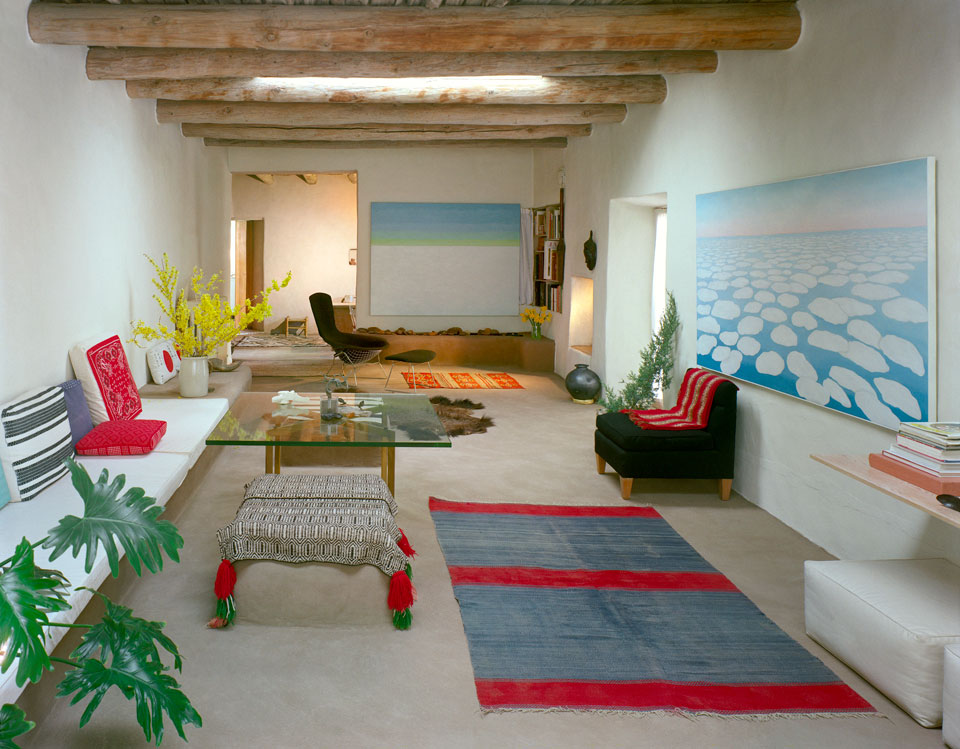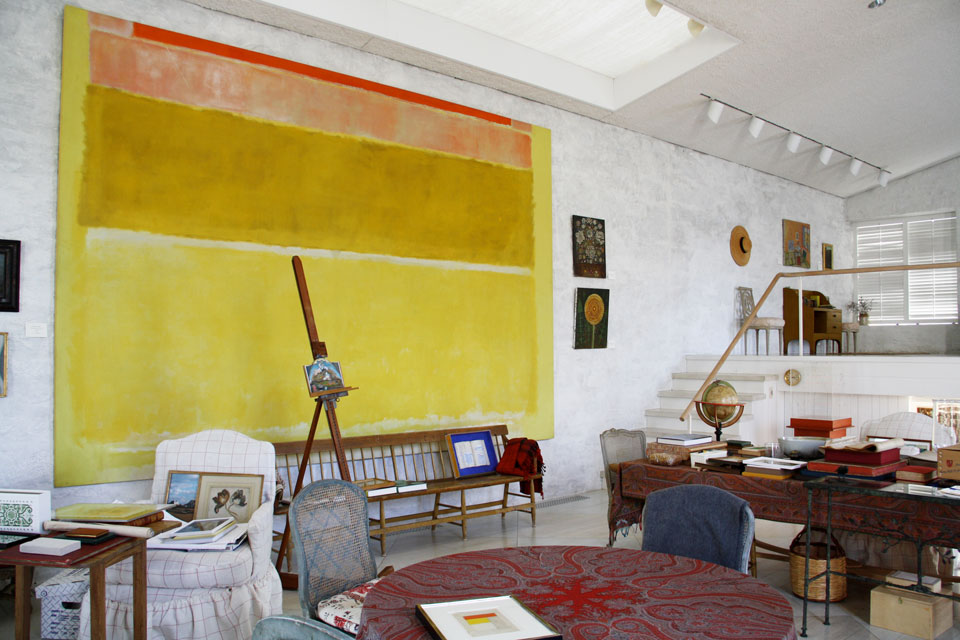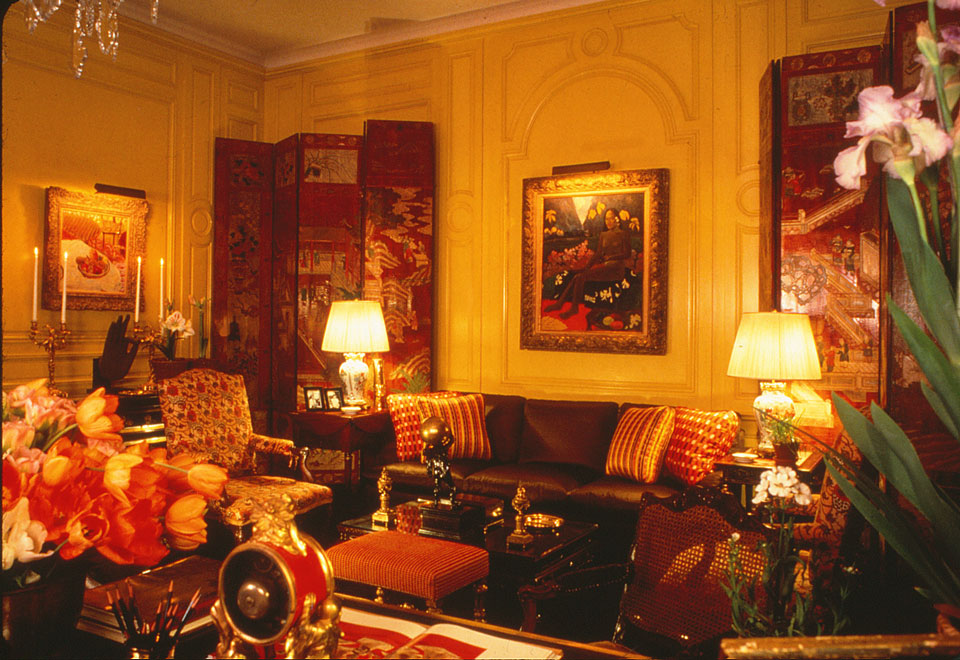
The library at Evangeline Bruce’s home in Albany, New York, decorated by Diana Phipps. A printed fabric in the exotic shades of the East was used on the walls and cupboards, taking inspiration from a copy of a seventeenth-century painting of Pocahontas in Jacobean dress. © How They Decorated: Inspiration from Great Women of the Twentieth Century by P. Gaye Tapp, Rizzoli New York, 2017
Take a look around your home — what do the surroundings say about you? Plenty, we bet. Now imagine being Babe Paley for a day and stepping into her wondrous home. Or Elsa Schiaparelli. Or Georgia O’Keeffe. Or Pauline Trigère. What a dizzying whirlwind of engaging interiors and enchanting personalities, right?
Picture the thrill of doing all of the above, and in one sitting. That’s what it is like flipping through P. Gaye Tapp’s How they Decorated: Inspiration from Great Women of the Twentieth Century, out this year by Rizzoli New York. A must for any decor lover, the book features the fabulous residences of various style icons — and it’s quite an inspirational head trip jumping from Schiaparelli’s grand Paris apartment, with its pagoda-like bookcases, to O’Keeffe’s eighteenth-century Spanish Colonial compound in Abiquiu, New Mexico. You’ll get a good glimpse at almost a hundred lush rooms from 16 bold-faced figures: the aforementioned Paley, Schiaparelli, O’Keeffe and Trigère as well as Lady Diana Cooper, Evangeline Bruce, Louise de Vilmorin, Sybil Connolly, Hélène Rochas, Gabrielle van Zuylen, Mona von Bismarck, Pauline de Rothschild, Fleur Cowles, Bunny Mellon, Dominique de Menil and Lesley Blanch.
“Whether exotic, urbane, cerebral, literary, or social, each of the subjects in How They Decorated moved to the beat of her own drum,” writes Charlotte Moss in the foreword. “There is no single formula. There is no single style. Each had her own creative intensity, her joy for life — some an unabashed delight with fashion, others a unique personal style laced with an unapologetic sans souci bohemianism, and still others a razor-sharp focus to achieve perfection. And then, there were the rarest of birds: those who knew that perfection was in the imperfect, that the unconventional was simply using conventional things unconventionally.”
Here, a closer look at some of the homes featured.

A peek inside Georgia O’Keeffe’s home at Abiquiú, New Mexico. Eighteenth-century rooms, like this one, had been used for trading and as sleeping quarters for Native American servants. The Eames chair, colorful Navajo rug, and vibrant pillows brightened the room’s austere palette. © How They Decorated: Inspiration from Great Women of the Twentieth Century by P. Gaye Tapp, Rizzoli New York, 2017

More from O’Keeffe’s residence in Abiquiú. Bancos at the base of the adobe walls were designed for sitting and sleeping. O’Keeffe’s Sky Above Clouds/Yellow Horizon and Clouds and Above the Clouds I hung in stark relief to the plain adobe walls and roughhewn vigas (rafters) overhead. In 1965 O’Keeffe allowed a rare glimpse of her rooms at Abiquiu in a story for House & Garden magazine. By the 1970s she began changing the colors in the sitting room to natural adobe shades, leaving primary colors behind. © How They Decorated: Inspiration from Great Women of the Twentieth Century by P. Gaye Tapp, Rizzoli New York, 2017

Lady Diana Cooper at the ambassadorial residence on Paris’ rue du Faubourg Saint-Honor — her husband served as ambassador after the Second World War. Here, she lies on Pauline Borghese’s grand Empire bed, photographed by none other than Cecil Beaton © How They Decorated: Inspiration from Great Women of the Twentieth Century by P. Gaye Tapp, Rizzoli New York, 2017

Bunny Mellon believed that “a garden, like a library, is a whole made up of separate interests and mysteries.” In the Oak Spring Garden Library, a monumental 1954 Mark Rothko canvas glows on whitewashed walls, with small canvases placed like planets revolving around the sun. For drama of scale, Mrs. Mellon displayed a small illustrated book on an easel in front of the large Rothko. Her eye was impeccable at capturing beauty in disparate objects, creating harmony in their placement. Along with her extensive collections, French and Shaker furniture and simple tables crafted on her farm simply adorned the library landscape. © How They Decorated: Inspiration from Great Women of the Twentieth Century by P. Gaye Tapp, Rizzoli New York, 2017

The color of the Paleys’ vibrant yellow Fifth Avenue living room was chosen by Mrs. Paley and the design firm Parish-Hadley. Each of the public rooms of the Paley apartment was as glamorous as the lady herself. George Stacey’s stunning brand of decoration had set off Babe Paley to perfection, but as she came into her own, the Stacey grandeur receded to reveal her fresh yet refined aesthetic. This living room was the sum of all that Babe herself personified — polish, sophistication, and legendary style. © How They Decorated: Inspiration from Great Women of the Twentieth Century by P. Gaye Tapp, Rizzoli New York, 2017






